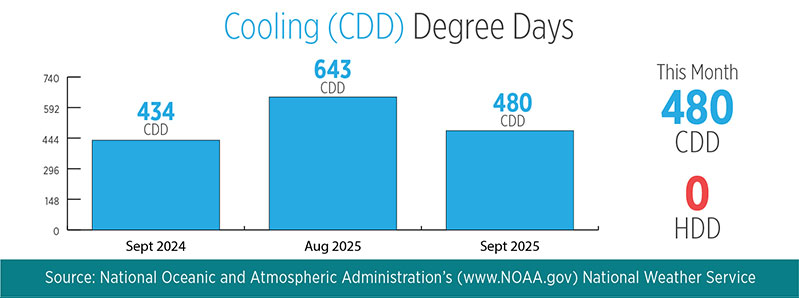
Lower 90s were the norm throughout a warm September, punctuated by a few storms that lowered temperatures to the 70s and even the 60s.
On September 4, the high temperatures soared to 102 degrees, marking the only 100-degree day of the month. North Texas experienced a total of seven 100-degree days this summer, the lowest since 2007, when there were five.
Just four days later, North Texans got their first taste of fall weather with a low of 63 degrees, though the official start of fall was Sept. 22.
The closer the average temperature is to 65 degrees, the less electricity that’s needed to keep the home or business comfortable. That’s the basis of the Cooling Degree Days and Heating Degree Days, which are explained below.
As we move into the shoulder months of October and November, mild temperatures typically become more common and, thus, energy usage goes down.
| August | September | Difference | |
|---|---|---|---|
| Average temperature | 85.5 | 80.8 | -4.7 |
| Heating Degree Days | 0 | 0 | 0 |
| Cooling Degree Days | 643 | 480 | 163 less CDD |
| Utilities and the federal government measure the impact of weather on energy usage by calculating Cooling Degree Days (CDD) and Heating Degree Days (HDD). To calculate the CDD, take the average temperature for a day and subtract it from 65. The higher the number, the more air conditioning will be needed to keep your home comfortable. Click here for more information on calculating CDD. | |||
RATES
CoServ’s strategic power purchase strategy continues to benefit Members in the form of lower electricity rates compared to the competition.
CoServ accounts for fluctuations in wholesale electricity costs by adjusting the Power Cost Recovery Factor (PCRF) up or down.
CoServ kept the PCRF at -0.01 per kilowatt-hour for October billing, meaning it subtracts one penny off the base rate. This marks the 16th straight month where CoServ's PCRF is negative.
The Standard residential rate for October will be 12.23 cents per kilowatt-hour.
CoServ has 100% control over our power purchases, so when we save money on wholesale electricity, we pass that on to Members, as we did this month.
Click here to learn more about how your CoServ rate is calculated.
Click here to compare our rates to the average retail electric provider in North Texas.




- « Previous
- 1
- 2
- 3
- Next »

